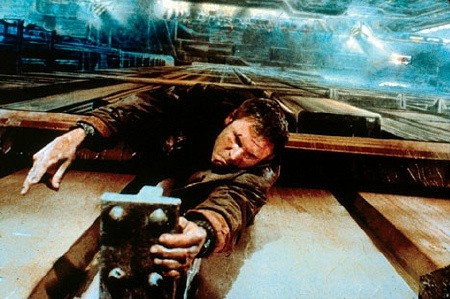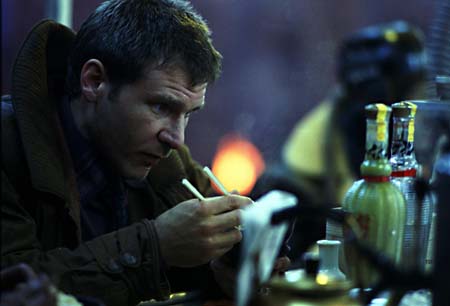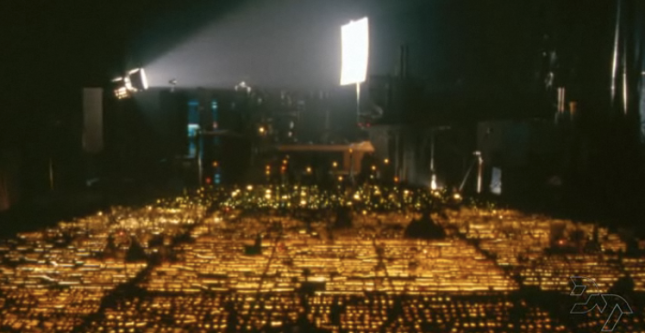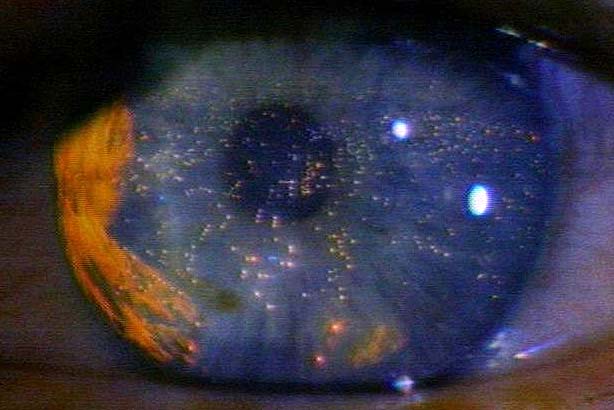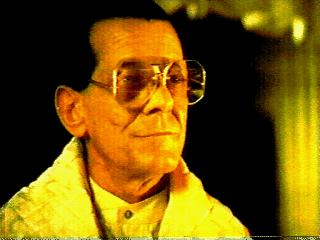This is great, it is a 16 mm promotional featurette that circulated through America’s horror, fantasy and sci-fi conventions on the release of Blade Runner in 1982. Featuring interviews with Ridley Scott, Syd Mead (visual futurist), and Douglas Trumbull (special effects), the short promotional film let viewers peer inside the making of the Blade Runner universe.
Category Archives: Blade Runner
Blade Runner back in business
The NZ Herald reports:
This sounds dangerous. A sci-fi film set in the distant future made in the recent past will now in the near future be the subject of a prequel set in what was once the distant future of the recent past, then a sequel set beyond that distant future.
Warner Bros are in the final stages of acquiring the film and television rights to produce sequels and prequels of Ridley Scott’s 1982 film Blade Runner – regularly named the best science fiction film ever made.
Read the rest here.
Good stuff!
Filmsite’s take on Blade Runner
Blade Runner (1982), rising director Ridley Scott’s follow-up to his hit Alien (1979), is one of the most popular and influential science-fiction films of all time – and it has become an enduring cult classic favourite. But the enthralling film was originally a box-office financial failure, and it received negative reviews from film critics who called it muddled and baffling. It also wasn’t encouraging that it faced Spielberg’s E.T.: The Extra-Terrestrial (1982) during its opening release. It received only two Academy Award nominations without Oscars: Best Art Direction/Set Decoration, and Best Visual Effects. The evocative, inventive, stylistic film has improved with age and warrants repeated viewings. The dense, puzzling, detailed plot of the film is backed by a mesmerizing, melancholy musical soundtrack from Greek composer Vangelis – undeservedly overlooked for an Oscar nomination. Stylistically, the film was arresting with fantastic, imaginative visual effects of a future Los Angeles conceived by futurist design artist Syd Mead, and influenced by the vision of Fritz Lang’s Metropolis (1927) and Kubrick’s 2001: A Space Odyssey (1968). [Mead had also been production designer for the same year’s visually-pioneering TRON (1982), teamed with famed French futuristic illustrator Jean “Moebius” Giraud.] Another inspiration for the film was the 1974 science fiction book by novelist Alan E. Nourse titled The Bladerunner, set in the year 2014 about people who sold medical equipment and supplies to ‘outlaw’ doctors who were unable to obtain them legally. Many films have attempted to duplicate the dystopic, cyberpunkish look of Blade Runner, including Batman (1989), Johnny Mnemonic (1995), Strange Days (1995), The Fifth Element (1997), Dark City (1998), The Matrix (1999), and I, Robot (2004). The ambitious, enigmatic, visually-complex film is a futuristic film noir detective thriller with all its requisite parts – an alienated hero of questionable morality, a femme fatale, airborne police vehicles called “Spinners”, dark sets and locations in a dystopic Los Angeles of 2019, and a downbeat voice-over narration. The film mixed in some western genre elements as well, and is thematically similar to the story in High Noon (1952) of a lone marshal facing four western outlaws.
Read the rest here.
Blade Runner Skyscapes
Blade Runner: Hades Landscape
In the first of a three part series, Doug talks about the creation of various effects sequences completed for Blade Runner. In this video, he focuses on creating the opening sequence referred to as the “Hades Landscape”. See here.
Film Noir
Last term we discussed film noir, mainly in connection with the future noir film Blade Runner and of course Dead Men Don’t Wear Plaid.
The term film noir (‘black film’) was coined by French film critics who noticed the trend of how ‘dark’, downbeat and black the looks and themes were of many American crime and detective films released in France to theatres following the war, such as The Maltese Falcon (1941), Murder, My Sweet (1944) and Double Indemnity (1944). A wide range of films reflected the resultant tensions and insecurities of the time period, and counter-balanced the optimism of Hollywood’s musicals and comedies. Fear, mistrust, bleakness, loss of innocence, despair and paranoia are readily evident in noir, reflecting the Cold War period. The criminal, violent, misogynistic, hard-boiled, or greedy perspectives of anti-heroes in film noir were a metaphoric symptom of society’s evils, with a strong undercurrent of moral conflict, purposelessness and sense of injustice. There were rarely happy or optimistic endings in noirs.
Classic film noir developed during and after World War II, taking advantage of the post-war ambience of anxiety, pessimism, and suspicion. It was a style of black and white American films that first evolved in the 1940s, became prominent in the post-war era, and lasted in a classic “Golden Age” period until about 1960 (marked by the ‘last’ film of the classic film noir era, Orson Welles’ Touch of Evil (1958)).
Remember, film noir is not a genre, but rather the mood, style, point-of-view, or tone of a film.
From Frankenstein to Blade Runner
From Mary Shelley to Kenneth Branagh and beyond…
Everything you ever wanted to know about Frankenstein…the myth, the novel, the movies, the comic books, the theatre plays, the bolts in the neck…
FrankensteinFilms.com has it all and even more!
The website highlights the power and influence of Mary Shelley’s story through the nineteenth and twentieth centuries. Apart from direct adaptations, there have been many variations and appropriations in a modern day context on the same idea, for example The X Files episode ‘The Post Modern Prometheus’ and later comic parodies, such as Young Frankenstein. A key element in Shelley’s text – the scientist ‘playing god’ (or perhaps it is more accurate to say that Shelley is commenting on man mocking God ) in a laboratory – is a common theme in many science fiction texts. The film Blade Runner is a text that obviously has direct connections to Shelley’s Frankenstein.
Simple Guide to Blade Runner
Blade Runner is set in a future Los Angeles (2019) when wealthy people have abandoned the earth for other worlds leaving only the poor and depressed behind. Androids, called Replicants have been created to perform tasks for humans but they became too advanced and were banned from the earth. Four have escaped and made their way to earth. Harrison Ford stars as Rick Deckard a special sort of policeman called a Blade Runner whose task it is to terminate the Replicants.
To read a simple but interesting commentary on the film’s storyline go here.
How Science became God in Blade Runner
Blade Runner is one of the most acclaimed dystopian films of all time. Its vision of the future has sparked a great deal of debate in the worlds of film, literature and science. In Blade Runner, we see a post-apocalyptic Los Angeles, full of darkness, acid rain and decay. Within this world are three scientists who, together, paint a very different picture of the science and scientists of the future. Read this article from Tony Schloss which discusses science and science in the film.
There are three scientists in the film, but the most important of them all and also the seemingly most powerful man in the society of the film is Tyrell. Tyrell is the president and super-genius of the Tyrell corporation, a huge company that makes the replicants, the artificial human slaves that have allowed humans to move off-world and colonize other planets. Tyrell is presented to the viewer as having a God-like presence. Only in his office do we see any essence of the sun and a calm space. The motto of his corporation is “More human than human”. He calls Roy Batty, the leader of the rogue replicants, his “prodigal son”. In the movie he is presented as the highest science authority and is constantly referred to by others as a genius. In addition to this he seems to be the leader in politics and other realms. The police seem to work in cooperation with the Tyrell Corporation, and the office of the corporation is the largest building in the city. The whole of society seems to revolve around the Tyrell Corporation, and Tyrell is the leader of it all. It becomes clear very quickly in the film that science and technology are two of the most important factors in this society. By presenting Tyrell to us, the leader of science and also like a God, we are led to believe that science is the work of the Gods. In a new type of creation theory, it is science and technology that has created the world. Without the replicants provided by Tyrell, we can presume that the creation of off-world colonies, which in turn led to the decay of earth, would not have been occurred. Science has become something that has always been feared- the maker and destroyer of worlds, an all-powerful beast, a God, and Tyrell is the head of it all.
Read the rest here.
Blade Runner notes
.gif)
Some of you are looking at Blade Runner and I am adding notes to moodle. Here is a little information to get you started.
Ridley Scott’s grim and gritty film Blade Runner, was based very loosely on the Philip K. Dick novel Do Androids Dream of Electric Sheep? In the film as it was originally released, Rick Deckard is a ‘Blade Runner’ a special member of the L.A police department who is employed to hunt down and “retire” replicants (genetically manufactured humans). Since they were declared illegal on Earth, it is up to the Blade Runners to “retire” any that find their way to Earth. At the beginning of the film, Deckard is called out of retirement after a group of six replicants hijack a shuttle to Earth, intending to pass themselves off as normal humans. Deckard is reluctant to resume work, but is told he has no choice and must use some of “the old Blade Runner magic” to succeed. He follows the model of a film noir detective, mixing the pursuit of clues and interviews with suspects with brutal violence.
Deckard is a loner, an angst-ridden killer who has started to identify more with the androids he’s hunting down than the humans he’s supposedly protecting. During his hunt, there is evidence to suggest he might be a replicant himself. At the end, he is attempting to flee the city with the replicant, Rachel, towards an uncertain future.
There is sooooo much information on the film but be careful that you know what version is being discussed. There is the original with tacked on happy ending (where did all that sunlight come from?), the director’s cut that has no voice-over and a more ambiguous ending and the final cut. And to avoid anymore confusion yes, Deckard is a replicant.
